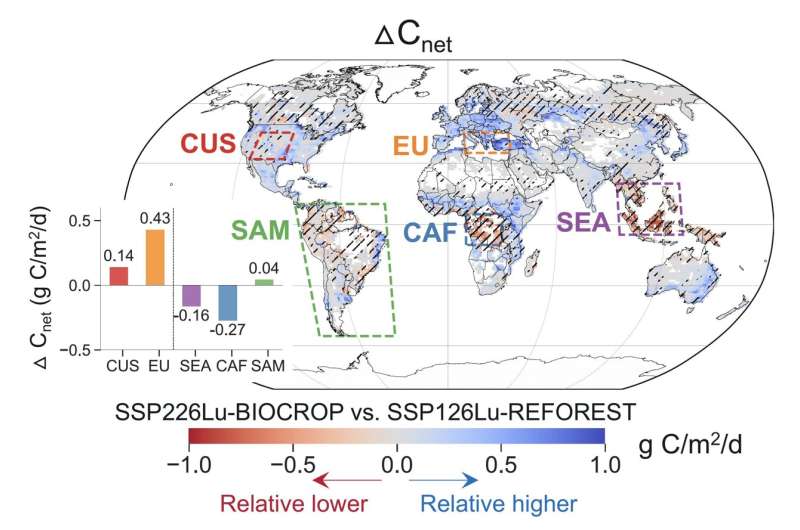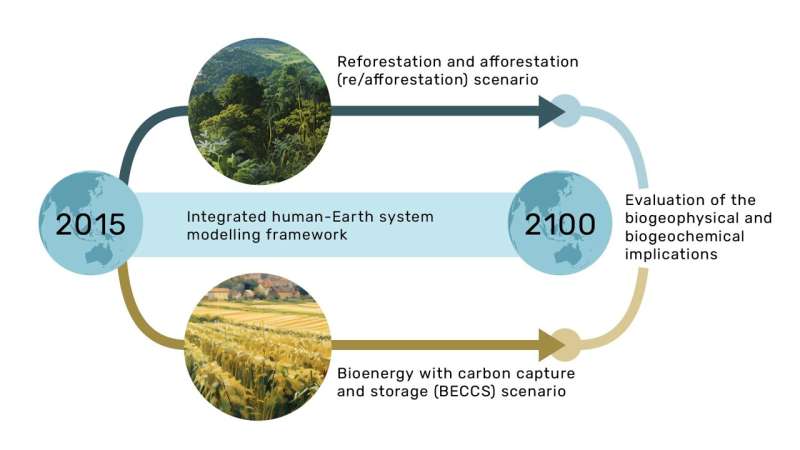Evaluating land-based mitigation strategies for achieving 2°C climate targets
Global warming poses a significant threat to ecosystems, societies, and economies worldwide. In recent decades, an international climate policy goal of limiting global warming to 2°C above pre-industrial levels was established. This was to avoid severe and irreversible impacts on the environment.
International agreements like the Paris Agreement and policy frameworks, including carbon pricing mechanisms, play a pivotal role in achieving this goal. Climate decisions are often driven by information and data obtained from simulation and modeling frameworks as they allow policymakers to assess the potential impacts of various policy options, understand the dynamics of the climate system, and evaluate the effectiveness of different mitigation and adaptation strategies.
Now, a team of researchers led by Assistant Professor He Xiaogang from NUS Civil and Environmental Engineering, has applied this approach to future land use planning and policy decisions aimed at mitigating climate change.
Specifically, they evaluated the biogeophysical and biogeochemical implications of two land-based mitigation scenarios using an integrated modeling framework. Their work was recently published in the Proceedings of the National Academy of Sciences.
Biogeophysical processes influence the physical environment, including changes in energy, moisture, and air movements within the atmosphere. These processes interact with land-driven biogeochemical processes such as carbon sequestration, where natural ecosystems like forests and oceans capture and store atmospheric carbon dioxide.
At the same time, biogeochemical processes can influence energy and moisture changes within the atmosphere. Together, these processes play critical roles in regulating Earth’s climate. Understanding these processes is therefore essential when developing effective strategies to mitigate climate change, or enable ecosystems or society to adapt to climate change.
In Asst Prof He’s study, an integrated human-Earth system modeling framework was applied to two mitigation scenarios—bioenergy with carbon capture and storage (BECCS), and reforestation and afforestation (re/afforestation)—to investigate their impact on land carbon sink and climate.

BECCS explores bioenergy (energy derived from biomass) in combination with carbon capture and storage technologies. Growing evidence indicates there are potential unintended consequences from large-scale bioenergy expansion, including bioenergy cultivation–induced carbon emissions and exacerbated water stress. Such consequences may outweigh the projected carbon removal benefits of BECCS.
Similarly, the biogeophysical response to re/afforestation in some regions can influence local microclimates, modify water cycles and influence the absorption and reflection of solar radiation. This may offset the climate benefits from forest carbon sequestration. Such mitigation measures can however be optimized if applied strategically, to maximize their environmental benefits.
Two co-developed scenarios were explored. Specifically, SSP226Lu-BIOCROP, which is focused on bioenergy expansion, and SSP126Lu-REFOREST which assesses re/afforestation. These scenarios are alternative land-based mitigation pathways that are based on the Shared Socioeconomic Pathways (SSPs), which are climate change scenarios of projected socioeconomic global changes up to 2100 as defined in the IPCC Sixth Assessment Report.
In their assessment, Asst Prof He found that the effective carbon sink (Cnet) associated with SSP126Lu-REFOREST is strongly dependent on the ability of environmental conditions to support forest growth in projected re/afforested regions.
Regions such as the Central United States and Europe exhibit small or no carbon gains in the re/afforested regions as they are predicted not to support tree growth, whereas regions such as Southeast Asia, Central Africa, and South America have much larger carbon gains as they exhibit successful forest growth.
In addition, the Cnet for SSP226Lu-BIOCROP is strongly dependent on assumptions related to BECCS technological progress and advancements. For example, SSP226Lu-BIOCROP exhibits a larger variation for Cnet due to uncertainties in future biomass yield, energy conversion technology, and the effectiveness of Carbon Capture and Storage (CCS).
It is stipulated that rapid technological advancements in biomass yield, biofuel conversion, and CCS technology could allow land in SSP226Lu-BIOCROP to be a considerably larger effective carbon sink as compared to SSP126Lu-REFOREST, and vice versa.
The study also uncovered the spatial- and season-dependent climate consequences of the two mitigation scenarios. SSP226Lu-BIOCROP is proposed to result in a cooler climate globally compared to SSP126Lu-REFOREST, but this is not uniform across regions and seasons. The relative cooling effect is more pronounced at high latitudes than in tropical and temperate regions, and during summer (Jun–Aug).
This is because the cooling benefit from the albedo effect—the ability of a surface to reflect sunlight back into space—is stronger than the warming contribution driven by the reduction in evapotranspiration. In contrast, the bioenergy-driven deforestation in tropical regions causes a relative warming effect when comparing SSP226Lu-BIOCROP to SSP126Lu-REFOREST.
All in all, Asst Prof He’s study advances our understanding of the impact of two land-based mitigation strategies and emphasizes the importance of considering technological advances and regional environmental conditions when designing effective land-based mitigation strategies.
It also highlights the significance of optimizing locations for re/afforestation and bioenergy expansion in future land use planning, so as to maximize the probability that any intended mitigation outcome will be achieved.
Notably, the study also reveals variable re/afforestation effectiveness across temperate regions, implying the possibility of synergistically integrating re/afforestation and bioenergy expansion to maximize climate mitigation outcomes.
These findings provide insights for strategic land-use planning and policy decisions, to better address climate change and optimize mitigation efforts at regional and global scales.
More information:
Yanyan Cheng et al, A bioenergy-focused versus a reforestation-focused mitigation pathway yields disparate carbon storage and climate responses, Proceedings of the National Academy of Sciences (2024). DOI: 10.1073/pnas.2306775121
Citation:
Evaluating land-based mitigation strategies for achieving 2°C climate targets (2024, March 20)
retrieved 20 March 2024
from https://phys.org/news/2024-03-based-mitigation-strategies-2c-climate.html
This document is subject to copyright. Apart from any fair dealing for the purpose of private study or research, no
part may be reproduced without the written permission. The content is provided for information purposes only.

Global warming poses a significant threat to ecosystems, societies, and economies worldwide. In recent decades, an international climate policy goal of limiting global warming to 2°C above pre-industrial levels was established. This was to avoid severe and irreversible impacts on the environment.
International agreements like the Paris Agreement and policy frameworks, including carbon pricing mechanisms, play a pivotal role in achieving this goal. Climate decisions are often driven by information and data obtained from simulation and modeling frameworks as they allow policymakers to assess the potential impacts of various policy options, understand the dynamics of the climate system, and evaluate the effectiveness of different mitigation and adaptation strategies.
Now, a team of researchers led by Assistant Professor He Xiaogang from NUS Civil and Environmental Engineering, has applied this approach to future land use planning and policy decisions aimed at mitigating climate change.
Specifically, they evaluated the biogeophysical and biogeochemical implications of two land-based mitigation scenarios using an integrated modeling framework. Their work was recently published in the Proceedings of the National Academy of Sciences.
Biogeophysical processes influence the physical environment, including changes in energy, moisture, and air movements within the atmosphere. These processes interact with land-driven biogeochemical processes such as carbon sequestration, where natural ecosystems like forests and oceans capture and store atmospheric carbon dioxide.
At the same time, biogeochemical processes can influence energy and moisture changes within the atmosphere. Together, these processes play critical roles in regulating Earth’s climate. Understanding these processes is therefore essential when developing effective strategies to mitigate climate change, or enable ecosystems or society to adapt to climate change.
In Asst Prof He’s study, an integrated human-Earth system modeling framework was applied to two mitigation scenarios—bioenergy with carbon capture and storage (BECCS), and reforestation and afforestation (re/afforestation)—to investigate their impact on land carbon sink and climate.

BECCS explores bioenergy (energy derived from biomass) in combination with carbon capture and storage technologies. Growing evidence indicates there are potential unintended consequences from large-scale bioenergy expansion, including bioenergy cultivation–induced carbon emissions and exacerbated water stress. Such consequences may outweigh the projected carbon removal benefits of BECCS.
Similarly, the biogeophysical response to re/afforestation in some regions can influence local microclimates, modify water cycles and influence the absorption and reflection of solar radiation. This may offset the climate benefits from forest carbon sequestration. Such mitigation measures can however be optimized if applied strategically, to maximize their environmental benefits.
Two co-developed scenarios were explored. Specifically, SSP226Lu-BIOCROP, which is focused on bioenergy expansion, and SSP126Lu-REFOREST which assesses re/afforestation. These scenarios are alternative land-based mitigation pathways that are based on the Shared Socioeconomic Pathways (SSPs), which are climate change scenarios of projected socioeconomic global changes up to 2100 as defined in the IPCC Sixth Assessment Report.
In their assessment, Asst Prof He found that the effective carbon sink (Cnet) associated with SSP126Lu-REFOREST is strongly dependent on the ability of environmental conditions to support forest growth in projected re/afforested regions.
Regions such as the Central United States and Europe exhibit small or no carbon gains in the re/afforested regions as they are predicted not to support tree growth, whereas regions such as Southeast Asia, Central Africa, and South America have much larger carbon gains as they exhibit successful forest growth.
In addition, the Cnet for SSP226Lu-BIOCROP is strongly dependent on assumptions related to BECCS technological progress and advancements. For example, SSP226Lu-BIOCROP exhibits a larger variation for Cnet due to uncertainties in future biomass yield, energy conversion technology, and the effectiveness of Carbon Capture and Storage (CCS).
It is stipulated that rapid technological advancements in biomass yield, biofuel conversion, and CCS technology could allow land in SSP226Lu-BIOCROP to be a considerably larger effective carbon sink as compared to SSP126Lu-REFOREST, and vice versa.
The study also uncovered the spatial- and season-dependent climate consequences of the two mitigation scenarios. SSP226Lu-BIOCROP is proposed to result in a cooler climate globally compared to SSP126Lu-REFOREST, but this is not uniform across regions and seasons. The relative cooling effect is more pronounced at high latitudes than in tropical and temperate regions, and during summer (Jun–Aug).
This is because the cooling benefit from the albedo effect—the ability of a surface to reflect sunlight back into space—is stronger than the warming contribution driven by the reduction in evapotranspiration. In contrast, the bioenergy-driven deforestation in tropical regions causes a relative warming effect when comparing SSP226Lu-BIOCROP to SSP126Lu-REFOREST.
All in all, Asst Prof He’s study advances our understanding of the impact of two land-based mitigation strategies and emphasizes the importance of considering technological advances and regional environmental conditions when designing effective land-based mitigation strategies.
It also highlights the significance of optimizing locations for re/afforestation and bioenergy expansion in future land use planning, so as to maximize the probability that any intended mitigation outcome will be achieved.
Notably, the study also reveals variable re/afforestation effectiveness across temperate regions, implying the possibility of synergistically integrating re/afforestation and bioenergy expansion to maximize climate mitigation outcomes.
These findings provide insights for strategic land-use planning and policy decisions, to better address climate change and optimize mitigation efforts at regional and global scales.
More information:
Yanyan Cheng et al, A bioenergy-focused versus a reforestation-focused mitigation pathway yields disparate carbon storage and climate responses, Proceedings of the National Academy of Sciences (2024). DOI: 10.1073/pnas.2306775121
Citation:
Evaluating land-based mitigation strategies for achieving 2°C climate targets (2024, March 20)
retrieved 20 March 2024
from https://phys.org/news/2024-03-based-mitigation-strategies-2c-climate.html
This document is subject to copyright. Apart from any fair dealing for the purpose of private study or research, no
part may be reproduced without the written permission. The content is provided for information purposes only.
